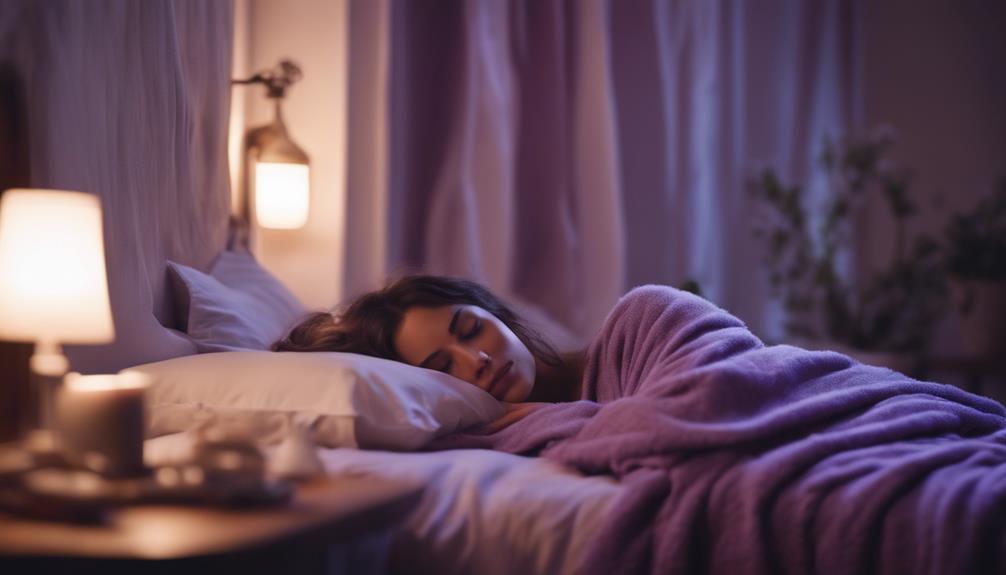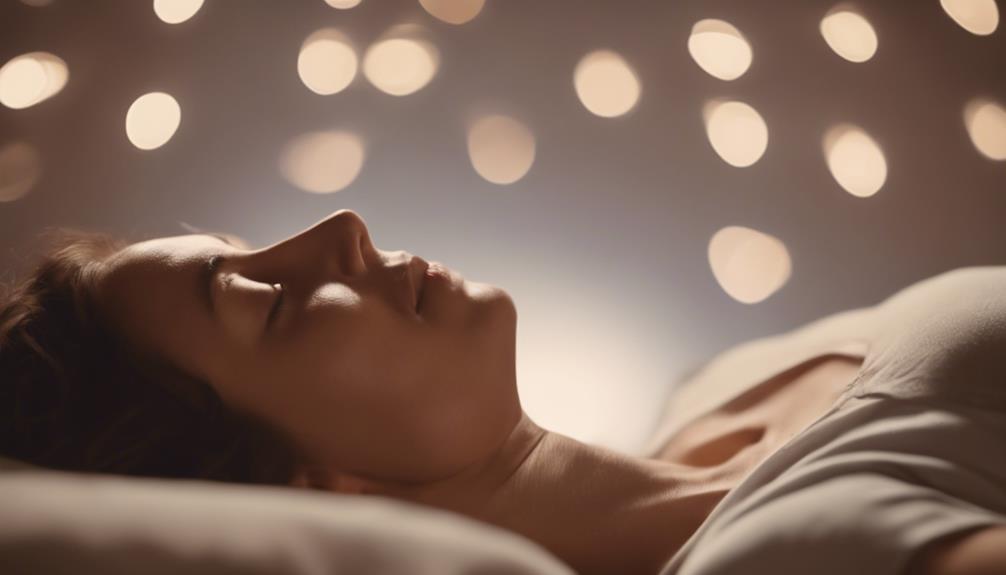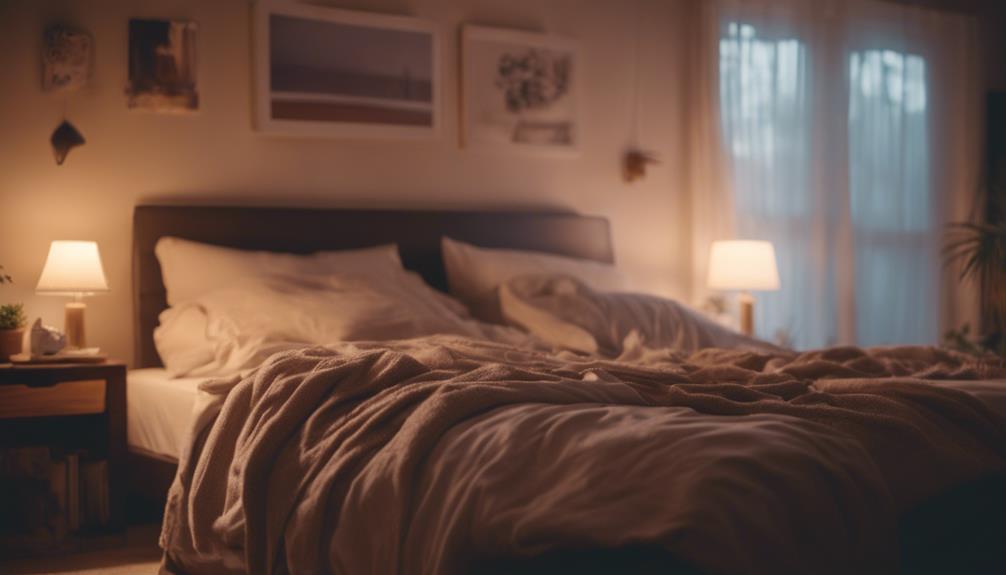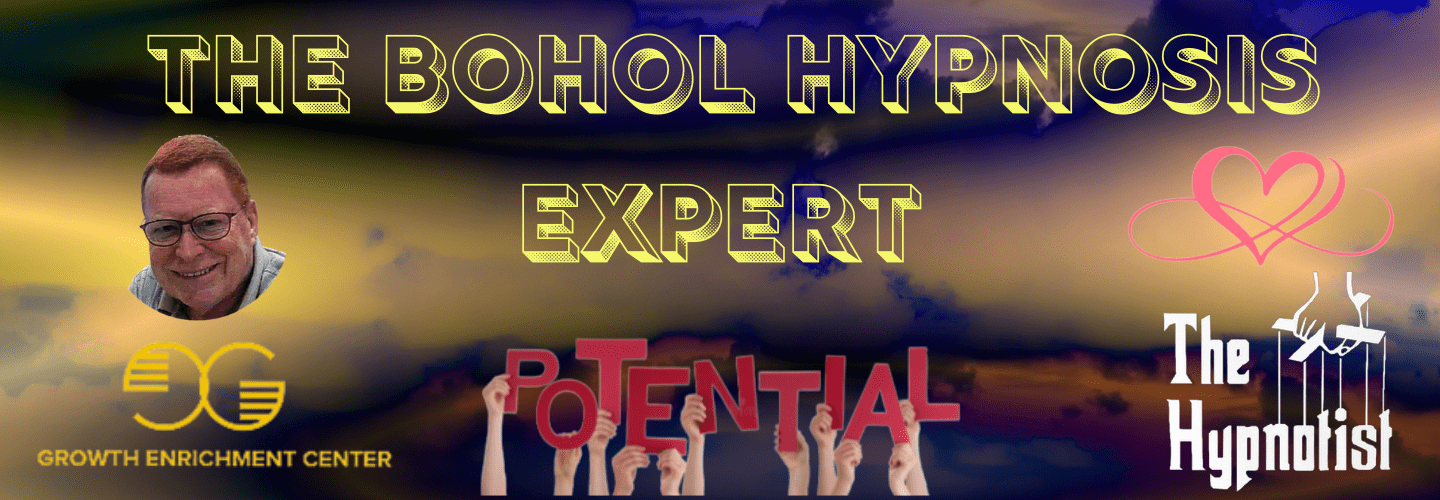
Self-hypnosis scripts like deep relaxation, progressive muscle relaxation, and visualizing peaceful sleep can give you insomnia relief. Counting down to sleep, body scan meditation, and guided imagery techniques are effective for deep relaxation. Utilizing breathing techniques for relaxation and anchoring positive sleep associations can aid in promoting restful sleep.
Subconscious mind reprogramming through self-hypnosis can transform negative sleep patterns. These scripts leverage the mind-body connection to enhance sleep quality and promote mental calmness. Additional techniques such as diaphragmatic breathing and cognitive therapy strategies can further support a consistent and restorative sleep routine.
Key Takeaways
- Use guided imagery techniques to induce relaxation and improve sleep quality.
- Practice self-hypnosis scripts for calming the mind and promoting restful sleep.
- Incorporate positive sleep associations into self-hypnosis routines.
- Utilize deep breathing and progressive muscle relaxation in self-hypnosis for insomnia relief.
- Engage in mindfulness techniques to reprogram the subconscious mind for better sleep.
Deep Relaxation Script
To facilitate a restful night’s sleep, utilizing a deep relaxation script can help induce a state of calmness and tranquility conducive to falling asleep peacefully. Incorporating mindfulness exercises into this script can assist individuals in becoming more aware of the present moment, letting go of racing thoughts, and embracing a sense of inner peace.
By focusing on the sensations of breathing or the body’s connection to the bed, mindfulness exercises can promote relaxation, reducing anxiety and stress that may hinder sleep initiation.
Additionally, integrating sleep affirmations into the deep relaxation script can further enhance its effectiveness. Positive statements such as ‘I am safe and secure as I drift off to sleep’ or ‘My mind and body are ready for rest’ can help reframe negative thought patterns and instill confidence in one’s ability to achieve a good night’s sleep.
Progressive Muscle Relaxation

Progressive Muscle Relaxation is a proven technique that involves tensing and relaxing specific muscle groups to promote relaxation. This method can help reduce physical tension and calm the mind, making it an effective tool for managing insomnia.
Deep Breathing Techniques
Utilizing deep breathing techniques can be a powerful method to induce relaxation and alleviate tension in the body, aiding in the journey towards better sleep quality for those experiencing insomnia.
Mindfulness exercises play an essential role in deep breathing practices by promoting present-moment awareness and helping individuals focus on their breath, thereby reducing racing thoughts that may hinder falling asleep. By incorporating mindfulness into deep breathing routines, individuals can create a calming bedtime ritual that signals to the body and mind that it is time to unwind and prepare for sleep.
In addition to mindfulness exercises, integrating sleep affirmations into deep breathing sessions can further enhance the relaxation response. Positive affirmations, such as ‘I am calm and at peace,’ or ‘My body is ready for a restful night’s sleep,’ can help reframe negative thought patterns and cultivate a sense of tranquility. When combined with deep breathing techniques, these sleep affirmations can reinforce a state of relaxation, making it easier to drift off into a restful slumber.
Body Scan Meditation
Incorporating body scan meditation into your relaxation routine can be a beneficial method for promoting deep physical and mental relaxation to combat insomnia.
Body scan meditation, a mindfulness practice, involves sequentially focusing on different parts of the body, bringing body awareness and releasing tension.
This technique encourages individuals to tune in to their bodies, noticing any areas of tightness or discomfort, and then consciously relaxing those muscles.
Visualizing Peaceful Sleep

Engage in a mental exercise to guide your mind towards a state of tranquil rest by vividly picturing a serene, comfortable sleep environment. As part of your bedtime routine, creating a peaceful sleep environment is essential for promoting relaxation and improving sleep quality. Your sleep environment should be conducive to rest, free of distractions, and comfortable. Consider incorporating calming elements such as soft lighting, comfortable bedding, and a comfortable mattress to enhance your sleep environment.
The mind-body connection plays a significant role in promoting restful sleep. By practicing bedtime affirmations that focus on relaxation and peaceful sleep, you can positively influence your mindset before bedtime. Affirmations such as ‘I am calm and at peace’ or ‘My body is ready for rest’ can help alleviate any stress or anxiety that may be impacting your ability to fall asleep.
Visualizing yourself in a serene, comfortable sleep environment and incorporating bedtime affirmations can help calm your mind and prepare your body for a restful night’s sleep. By nurturing a tranquil mental space, you can enhance your ability to drift off into a peaceful slumber.
Counting Down to Sleep

When struggling with insomnia, counting down to sleep can be a helpful technique to calm the mind and facilitate relaxation.
By focusing on the numbers and pairing them with deep, rhythmic breathing, individuals can create a soothing mental environment conducive to falling asleep.
Additionally, incorporating visualization of peaceful scenes can further enhance the effectiveness of this self-hypnosis method for insomnia relief.
Relax With Numbers
Utilizing the technique of counting down with numbers can be a soothing and effective method to ease into a state of relaxation conducive to falling asleep. Number visualization involves picturing each number in your mind as you count, creating a mental image that can help distract from racing thoughts and promote a sense of calm. Numerical relaxation techniques, such as counting backward from 100 or visualizing each number floating away like a balloon, can be particularly useful for individuals struggling with insomnia.
As you engage in this practice, focus on the numbers and the act of counting, allowing it to guide your mind away from stressors and towards a state of tranquility.
Focus on Breathing
To enhance your self-hypnosis practice for better sleep, focusing on your breathing and incorporating a counting-down technique can be a beneficial approach.
Mindfulness exercises involving deep and intentional breathing can help calm the mind and body, preparing you for a restful night’s sleep.
Here are some key elements to bear in mind when incorporating breathing techniques into your self-hypnosis routine:
- Deep Breathing: Start by taking slow, deep breaths in and out, focusing on the sensation of the air entering and leaving your body. This can help relax your muscles and quiet your mind.
- Counting Down: Pair your deep breathing with a counting-down technique. For example, count down from 10 with each exhale, allowing yourself to sink deeper into a state of relaxation with each count.
- Sleep Affirmations: While focusing on your breath and counting down, incorporate sleep affirmations such as ‘I am calm and ready for sleep’ or ‘My mind and body are relaxed,’ reinforcing positive thoughts and intentions for a peaceful night’s rest.
Visualize Peaceful Scenes
Begin your self-hypnosis practice by visualizing peaceful scenes as you count down to sleep, allowing yourself to immerse in a tranquil mental landscape conducive to relaxation and rest.
As you close your eyes, imagine a serene setting such as a gentle stream in a forest, a meadow with flowers swaying in the breeze, or a quiet beach at sunset. Incorporating nature sounds like rustling leaves, flowing water, or birds chirping can enhance the sense of calmness and aid in easing you into a state of deep relaxation.
Guided meditation can complement this visualization exercise by providing a structured framework to follow as you navigate through your peaceful mental imagery.
Body Scan Meditation

The practice of body scan meditation involves systematically focusing on different parts of the body to promote relaxation and awareness. This mindfulness technique can be particularly helpful in promoting the relaxation response, which is essential for improving sleep quality and managing insomnia.
Key Benefits of Body Scan Meditation:
- Mindful Body: Body scan meditation encourages individuals to pay attention to the sensations in each part of their body, promoting a sense of mindfulness and presence in the moment.
- Relaxation Response: By systematically moving attention through different body parts, this practice helps trigger the relaxation response, reducing stress and tension that can interfere with sleep.
- Increased Body Awareness: Regular practice of body scan meditation can enhance body awareness, making it easier to identify and release areas of tension that might be contributing to sleep difficulties.
Incorporating body scan meditation into a bedtime routine can be a valuable tool for those seeking relief from insomnia and looking to improve their overall sleep quality.
Guided Imagery for Sleep

Utilizing guided imagery techniques can be a beneficial strategy to promote relaxation and facilitate better sleep quality for individuals experiencing insomnia. Color visualization is a powerful tool in guided imagery where individuals imagine soothing colors like blue or lavender surrounding them, creating a sense of calm and tranquility that can help ease them into sleep.
By focusing on these calming hues, the mind is redirected from racing thoughts that often contribute to sleeplessness.
Incorporating nature sounds into guided imagery can further enhance the relaxation experience. Imagining oneself in a serene natural setting, such as a peaceful forest or by a gentle stream, while listening to nature sounds like rustling leaves or flowing water, can create a soothing auditory environment conducive to sleep.
The combination of color visualization and nature sounds can transport individuals into a peaceful mental space, helping them let go of tension and stress, ultimately promoting a restful night’s sleep.
Breathing Techniques for Relaxation

Deep and intentional breathing practices have been shown to be effective in promoting relaxation and reducing stress levels, making them valuable tools for managing insomnia and improving sleep quality. Incorporating mindfulness meditation techniques into your breathing exercises can further enhance their calming effects.
Here are three key breathing techniques that can aid in relaxation and stress reduction:
- Diaphragmatic Breathing: Also known as belly breathing, this technique involves breathing deeply into the diaphragm, allowing the abdomen to rise and fall with each breath. It helps activate the body’s relaxation response and promotes a sense of calmness.
- 4-7-8 Breathing: Inhale quietly through the nose for a count of 4, hold the breath for a count of 7, then exhale audibly through the mouth for a count of 8. This technique can help regulate breathing patterns and induce relaxation.
- Box Breathing: This technique involves inhaling for a count of 4, holding the breath for 4, exhaling for 4, and then holding the breath again for 4. It can promote a sense of balance and reduce stress levels.
Incorporating these breathing techniques into your daily routine can help relax the mind and body, paving the way for a restful night’s sleep.
Anchoring Positive Sleep Associations

Establishing positive sleep associations can greatly enhance the quality of your sleep and help you overcome insomnia more effectively. Sleep hygiene plays a pivotal role in creating a conducive environment for restful sleep. This includes maintaining a consistent sleep schedule, creating a calming bedtime routine, and ensuring your sleep environment is comfortable and free of distractions.
By incorporating these practices into your daily routine, you can signal to your body and mind that it is time to unwind and prepare for sleep.
Cognitive therapy is another effective tool for anchoring positive sleep associations. This therapy focuses on challenging and changing negative thought patterns and beliefs that may be contributing to your insomnia. By reframing your thoughts about sleep and addressing any underlying anxieties or stressors, cognitive therapy can help you develop a healthier mindset towards sleep.
Incorporating both sleep hygiene practices and cognitive therapy into your self-hypnosis sessions can boost their effectiveness in promoting restful sleep and alleviating insomnia. By consistently reinforcing positive sleep associations through these techniques, you can improve your overall sleep quality and well-being.
Subconscious Mind Reprogramming

Reprogramming the subconscious mind is an essential aspect of self-hypnosis techniques aimed at addressing insomnia and improving sleep quality. By targeting the subconscious with positive suggestions, individuals can reshape their sleep patterns and promote better rest.
Here are three key ways in which subconscious mind reprogramming can benefit those struggling with insomnia:
- Subliminal Messages: Utilizing subliminal messages during self-hypnosis can help bypass resistance from the conscious mind and directly influence the subconscious. These messages are designed to instill positive beliefs and associations related to sleep, facilitating a deeper state of relaxation conducive to restful nights.
- Mind-Body Connection: Reprogramming the subconscious fosters a stronger mind-body connection, promoting overall mental health and well-being. By addressing underlying stressors or anxieties through hypnosis, individuals can create a more harmonious internal environment that supports healthy sleep patterns.
- Improved Sleep Patterns: Through consistent subconscious mind reprogramming, individuals can experience a shift towards more regular and restorative sleep patterns. This can lead to a significant improvement in sleep quality and overall sleep satisfaction, ultimately enhancing one’s daily functioning and quality of life.
Frequently Asked Questions
Can Self-Hypnosis Scripts Be Used During the Day for Relaxation?
Daytime applications of self-hypnosis scripts can effectively promote relaxation, reduce stress, enhance work productivity, and improve mental clarity. Utilizing these techniques during the day can provide a beneficial tool for managing daily stressors.
How Often Should Self-Hypnosis Scripts Be Practiced for Best Results?
To optimize the effectiveness of self-hypnosis scripts, consistency is key. Research suggests that practicing self-hypnosis scripts daily for at least 20 minutes can yield significant benefits. The frequency and duration of practice contribute to achieving desired results.
Are There Any Specific Self-Hypnosis Scripts for Different Types of Insomnia?
When addressing different types of insomnia, tailoring self-hypnosis scripts to specific sleep disturbances can be beneficial. Incorporating sleep hygiene practices and mindfulness techniques in these scripts can enhance their effectiveness in promoting better sleep quality and duration.
Can Self-Hypnosis Scripts Help With Anxiety-Related Sleep Issues?
Effective self-hypnosis scripts can aid in managing anxiety-related sleep issues by promoting relaxation and addressing underlying stressors. Combining anxiety management techniques with self-hypnosis can enhance sleep quality and alleviate sleep disorders.
Are There Any Potential Side Effects of Using Self-Hypnosis for Insomnia?
When considering self-hypnosis for insomnia, it’s crucial to acknowledge potential risks and precautions. While generally safe, side effects may include drowsiness, vivid dreams, or disorientation. Effectiveness varies, so exploring alternative therapies with a healthcare provider is advisable.
Conclusion
To sum up, utilizing self-hypnosis scripts can be an effective tool for relieving insomnia and promoting restful sleep. By incorporating deep relaxation, progressive muscle relaxation, visualization, and other techniques, individuals can reprogram their subconscious mind for improved sleep patterns.
These evidence-based strategies offer a holistic approach to addressing insomnia and can help individuals achieve a sense of calm and relaxation before bedtime. Remember, a well-rested mind leads to a well-rested body.
Take the Next Step, Make An Appointment
Do not be afraid to reach out to me, Mark , to assist you in any issues you might have. Need a good listener or someone to confidentially talk too? . Life Coaching is 45 minute session, once a week.
Self-Hypnosis is taught in one session, individual sessions or in a group, and lasts a lifetime. Most Hypnotherapy sessions including Age regression last 2 hours and EFT Sessions are usually handled with a one hour session
To make an appointment, first listen to the Pre-talk and fill out the Complementary Healthcare Provider Disclosure. The use the Contact Form to request an appointment with, Mark, The Bohol Hypnosis Expert.





